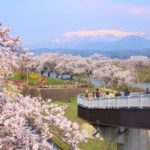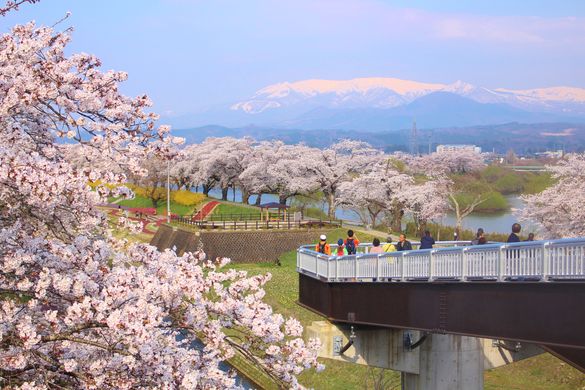 Sakura and Snow: When Spring Meets Winter in Tohoku
Sakura and Snow: When Spring Meets Winter in Tohoku
Winter is ending and the deep snows of northern Japan are melting. It is just the right time to visit the Tohoku Region, the “hidden gem” of Japan. Tohoku means “Northeast” and the Tohoku Region is located in the northern part of the main island of Honshu, between Tokyo to the south, and Hokkaido across the strait to the north.It is a less developed part of Japan with 70% of the land being covered by forest. It has seacoast on three sides, so it is well endowed with the scenery, and the natural products, of ocean and mountain.
The Tohoku Region consists of six prefectures, all of which are connected to Tokyo by high-speed Shinkansen trains. Fukushima City, the capital of Fukushima Prefecture, is the closest to Tokyo, 90 minutes by Shinkansen, while Aomori City, Aomori Prefecture, is farthest from Tokyo, about three hours by Shinkansen.
Tohoku has rich natural beauty: a visual delight in each season. Most of the forests in the Tohoku region are diverse deciduous broad-leaved forests, so in the spring you can see a world of translucent new leaves and pretty flowers, and in the summer a world of thick greenery and thriving wildlife. In autumn, you can enjoy the colorful leaves of red, yellow, and orange and the sounds of insects, and in winter, enjoy the many artistic landscapes, like sumie ink painting, created by the dark limbs of trees that have lost their leaves and the stark white snow.
The people of the Tohoku region have lived in harmony with nature for many centuries, both enjoying and surviving the flow of the seasons every day. Thanks to heavy snow, and fine water, the Tohoku region is one of Japan’s leading rice-growing regions (30% of all rice production in Japan). The local people live a peaceful existence, enjoying the cultural richness of many traditional festivals, folk tales and local crafts.
Life in harmony with nature is at the core the Tohoku
Region where authentic, traditional Japan is still thriving. This season, when the snow melts and cherry trees blossom, is one of the best times to experience the charms of Tohoku. In this newsletter, we will introduce some spots in Tohoku where you can enjoy the beautiful contrast of sakura and snow.
From winter to spring: Snowy mountains and Cherry Blossoms” (early April to mid-April)
In winter the Tohoku Region is covered with deep snow, blown in on cold wet winds from Siberia across the Sea of Japan. When cherry blossoms begin to bloom at lower altitudes there are many spots where one can view the lovely contrast of delicate blossoms with snow-capped mountains in the background. One such place is Hitome Senbonzakura on the Shiroishi River, near Sendai. “Hitome” means “at one glance,” and “Senbonzakura” means “a thousand cherry trees.” There are in fact a thousand trees along the river bank and you can enjoy most of them in one view. Behind them, the Zao Mountains are still covered in pristine snow.
Hirosaki: castle moat covered by a “flower raft” (mid-April to late April)
Hirosaki Castle is famous in itself as a tourist destination, but at cherry blossom time it becomes even more of an attraction. The park around the castle is filled with 2,600 of cherry trees, making for a very romantic view. And if that were not enough, when the cherry blossoms begin to fall, they cover the tranquil surface of the old moat, making a colorful surface covering, what is called a “flower raft.” The combination of castle, trees and moat is simply marvelous. And from the park you can also get a nice view of the snow-capped Mount Iwaki in the distance. To view all this you can take Shinkansen trains to Shin-Aomori and then local service to Hirosaki.
Hirosaki is also famous for its apple cultivation. Perhaps surprisingly both apple trees and cherry trees are members of the same botanical family. In Hirosaki Park, there is an official tree surgeon nicknamed “Sakura-mori ” (protects the cherry trees) who manages the cherry trees and utilizes apple pruning techniques to make Hirosaki’s cherry trees bloom bigger and even more beautiful. It is home to Japan’s oldest Somei Yoshino cherry tree, a hybrid renowned for its delicate flowers. In addition, there are still cherry trees of the type Edohigan-zakura in Tohoku that are over 1,000 years old, and their glorious petals bloom every year, revitalizing people after the long winter.
Suibotsu-rin: a submerged forest (usually mid-April to mid-May)
As snow melts, the thaw water flows into Shirakawa Dam Lake partially covering the trees so that only their upper branches project. This fantastical sight only lasts until mid-May when the lake begins to discharge water for rice planting so this scene is available for only a month. The waters recede and the trees and lake return to a more normal view. During the high-water time it is wonderful to take a walk around the lake in the morning mist, or for the more adventurous to cross the water with canoes, kayaks, or stand-up paddleboards.
In addition to Shirakawa Dam Lake, the fantastic scenery of submerged forests can also be seen in Akita and Iwate prefectures.
Suikyo: water mirrors cover the landscape (usually early May to early June)
As mentioned, Tohoku is a region of heavy rice production. In the spring, when snow melts and pours into the rice fields, “water mirrors” (suikyo) appear across the countryside. This phenomenon occurs only for a limited time, until the rice seedlings begin to grow. During this suikyo period the sky, clouds, and moon are reflected in the water of the rice fields, making them look like a huge mirrors. If you ride the Tohoku, Akita and Yamagata Shinkansen, which run through this region of many rice fields, you can enjoy these enchanting water mirrors from the train window.
Kagami Numa: Where the dragon’s eye opens (usually mid-May to mid-June)
Melting snow produces many unusual events in Tohoku. One of the strangest is at Kagami-Numa marsh (numa) located in dense forest near the summit of Mt. Hachimantai. This marsh, or lake, resembles numerous other volcanic lakes but in mid-May or mid-June the thawing snow forms white and blue circles, resembling a huge eye, known as the “Dragon’s Eye.” This remarkable sight only lasts for about a week until all the snow melts away. But when the dragon open’s its eye, it is time to rejoice because it heralds the coming of spring.
2023: Year of the Rabbit
Every spring when the snow melts on Mt. Azuma-Kofuji in Fukushima, it leaves behind the shape of a giant white rabbit on the side of the mountain. This rabbit is auspicious and signals that the farming season has arrived. The rabbit (usagi) is especially appropriate this year, the Year of the Rabbit. The mountain is an active volcano shaped like a small Mount Fuji (Kofuji). You can drive to the top and see the visitor’s center, and take a short walk around the rim. Because of this volcanic activity there are many delightful onsen (hot spring) inns in the vicinity.
Mt. Iwate: An eagle appears each spring (usually April)
Just as a rabbit appears at Azuma-Kofuji, at Mt. Iwate the receding snow on its peak reveals the rocky silhouette of an eagle every spring. This powerful mountain looms above Morioka and the eagle can be viewed from the Kaiun-bashi bridge in the city. During the warmer months the mountain is popular for a climb to the summit. The mountain has two nicknames: Nambu Katafuji (“the one-sided Fuji of the Nambu area”) and Ganju-san (“rock eagle mountain”). Morioka was recently recommended in The New York Times list of ’52 Places to Go in 2023′.
Sansai Ichiba: the springtime farmers markets of Tohoku
In pre-modern times, winters were difficult in mountainous, snowy Tohoku. The first growth of spring greens was a great relief to local people. Farmers markets are fun to visit anywhere in the world, but the springtime markets of Tohoku are especially nice. Sansai means “mountain vegetables” and these springtime delights, that grow right through the snow, include exotic greens such as bracken and fern, as well as young bamboo sprouts. As a tourist you may just take photos of the produce, but you will be able to taste these delicious greens in local cuisine while you are in Tohoku.
Mount Gassan: ski in the summer (usually from April to June, sometimes July)
The snow is so deep in winter that Gassan Ski Resort, on 1,984-meter Mt. Gassan in Yamagata, only opens in April, this year on 10 April. It is inaccessible before then. So it offers the enthusiastic skier a chance to ski in the springtime, and sometimes into summer. As the air warms the skier has a chance to enjoy the sunny slopes in a T-shirt. The view at the top is spectacular and the ski courses offer fun for all, ranging from beginner (30%) to intermediate (40%) to advanced (30%).
There are bamboo shoots harvested here on Gassan. They are said to be the only bamboo shoots that grow wild, and they can be eaten in the spring when the ski slopes open. These hardy shoots poke up right through the snow.
Yuki no Kairo: driving through a snow corridor (usually from early April to early May)
Spring arrives a bit late in cold Tohoku, and only in April can some roads finally be cleared of snow. This snow is piled into towering banks on each side of the road creating a Yuki no Kairo or a “Snow Corridor.” It is great fun to travel through these towering white embankments which can rise to nine meters in height. One location to see this is Route 103 on Mt. Hakkoda in Aomori. This road connects Sukayu Onsen and Yachi Onsen, two local hot springs resorts where you can enjoy traditional bathing at an inn.



















